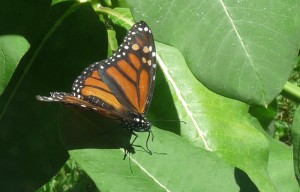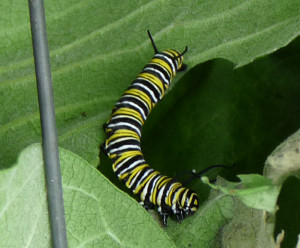(Click on the following link to listen to an audio version of this blog … Monarchs
Over the past 12 years I have written ten blogs about monarch butterflies. At our former home in Pennsylvania, we had front-row seats to watch the mid-summer, monarch flocks arrive from the south. These adult butterflies laid their eggs on our scattered, local, milkweed patches and then faded-out and died. Their hatching caterpillars then devoured the milkweed leaves, spun their cocoons, and metamorphosed into a new cohort of adults that resumed the species’ migration push to the north!
Maps show the steadily expanding Spring and Summer line of movement of these butterflies: In March the flocks are in the southern-most parts of the country, between Texas and Florida, by April they have traveled north to a line roughly between Oklahoma and South Carolina, and, then, by May they have moved up past a line between Kansas and Maryland. By early June they reach a line that stretches from Iowa to Ohio, and by late June they finally get to Pennsylvania, New York and New England.
The monarchs are reproducing all along the way (so both nectar producing plants (to provide food for the adult butterflies) and milkweed (to provide food and habitat for the developing caterpillars) are critical at each location!). The loss of these “weed-stops” due to agriculture and herbicide use is one of the main reasons that monarch butterflies are in such a precipitous state of decline! The monarchs fly north with the historical expectation of encountering an abundance of these plants and, in recent years, are more likely to encounter herbicide-treated, weed-free corn and soybean fields!
At each stop along the migration chain, the mated females lay between three to four hundred eggs each on the milkweed (spreading their eggs out over a large number of plants) before they die. The eggs hatch in three to five days depending on the temperature, and the emerging larvae (the “caterpillars”) feed first on their egg capsules and then begin to eat the milkweed leaves. They molt five times during their larval life stage and increase their body mass more than two thousand times. The caterpillars take between 9 and 14 days to go through their five instar growth phases.
The duration of this development at each stop on the migration chain has been historically sufficient to allow the next, more immediately northernly located patch of nectar producing plants and milkweed sufficient time to grow, develop and flower so that the migrating monarchs always encounter plants that are optimally ready to satisfy their needs! A number of climate change models have shown, though, that this precise coordination of plant development and monarch migration rates is breaking down! So, along with human impacts on weed abundance, alteration of climate/plant patterns is also playing a role in the decline of North America monarchs!
The monarch eggs and the larvae growing in the milkweed patches are under intense predation and parasite pressures. More than ninety percent of the eggs and caterpillars fail to survive. Eggs are eaten by ants, earwigs and snails, and larvae are eaten by beetles and other insects (like paper wasps) or killed by parasitoid wasps, bacteria, or fungi. Since the larvae feed exclusively on milkweed leaves they accumulate in their body tissues the milkweed’s cardenolides (a cardiac glycoside that can cause the heart of a vertebrate to stop its contractions!). These cardenolides make the larvae (and, eventually, the adults) poisonous to most vertebrates.
The end stage caterpillar then forms a chrysalis within which the tissues and organs of the larvae dissolve and are reformed into the structures of the butterfly. This metamorphosis takes between nine and fifteen days. The adult butterfly then emerges, mates, and continues on its migration journey.
So at each location, the caterpillars are seen a week or so behind the initial appearance of the arriving adults, and the adults from these caterpillars who then push on northward emerge from their chrysalises about a month later. By late July, migrating adults and caterpillars in many stages of coming and going are all over Western Pennsylvania. It takes anywhere from three to six mating/development cycles for the monarchs to reach the northern edges of their North American range!
Pennsylvania is just one of stops on this seasonal northward surge and eventual southward retreat of monarchs. Some of the adult monarchs that hatch here in mid-summer might, in a typical year, continue on north to lay more eggs on the later developing milkweed in New York and New England. I remember in the early 1980’s seeing clouds of monarchs along the New York State Thruway just west of Syracuse! These butterflies may have had a part of their life cycle tied to the fields of Western Pennsylvania.
Other monarchs that mature in Pennsylvania in late summer, though, will turn around and begin the long journey back south. These late summer/early fall born monarchs are part of the overwintering cohort that tries to find their way to the coniferous forests in the mountains of the Mexican states of Michoacán and Mexico. These overwintering monarchs live 8 or 9 months (compared to 2 to 5 week life span of the “summer” monarchs) and will be the individuals that push back north into Texas next February and March where they will mate and lay eggs thus starting the migration cycle all over again!
From year to year we have had both good news and bad news about the numbers of monarchs overwintering in Mexico or being counted at sites along their migration pathways. These year to year fluctuations, though, sometimes obscure the main story about the monarchs: in the past 30 years North American monarch populations have declined by 85 to 95%! The species is teetering on the edge of extinction!
A few weeks ago the International Union for the Conservation of Nature made this imperiled status of the monarch butterfly official. They placed the species on its “red list’ of threatened species and have classified it as “endangered” just two steps away from extinction!
What can we do to help stave off the extinction of this charismatic animal? We need to give it places to feed and reproduce! We need to plant a series of milkweed and flowering weed patches all the way from Texas to New England and make sure that these patches are ideally timed for the passing flocks of migrating monarch butterflies! We need to stop using so many herbicides and start planting more native plants that will serve the food and reproductive needs not only of the monarchs but also all of those other, lesser known insects and all of the birds and mammals that they sustain. We have got to think about all of life around us and nurture and encourage it. It’s time for us as a species to grow up!!






